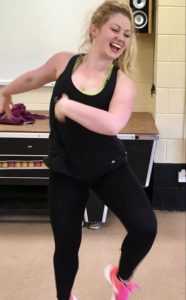 Sophie came to a yoga workshop; she’s a Zumba teacher and I went to one of her classes. She has infectious enthusiasm and it was fun – I loved it! She needs to stretch more, she says, and I need to move more. If only we could swap classes but we both teach at the same times each week! We both enjoy and benefit from opposite approaches, possibly characterised by, on the one hand, a lot of lying down and being still, and the other, never stopping. So how does yoga compare to other forms of fitness and exercise and what are the unique benefits of yoga exercise?
Sophie came to a yoga workshop; she’s a Zumba teacher and I went to one of her classes. She has infectious enthusiasm and it was fun – I loved it! She needs to stretch more, she says, and I need to move more. If only we could swap classes but we both teach at the same times each week! We both enjoy and benefit from opposite approaches, possibly characterised by, on the one hand, a lot of lying down and being still, and the other, never stopping. So how does yoga compare to other forms of fitness and exercise and what are the unique benefits of yoga exercise?
The fundamental difference is that yoga emphasises a long, slow stretch and contraction of muscles. Gym workout, for instance, emphasises repeated, short powerful movements. This produces quantities of lactic acid in the muscle fibres that cause fatigue and muscle stiffness. In yoga, movements are slow, the whole session a long alternation of effort and relaxation. Rest periods with breathing – savasana, lying down – mean that oxygen debt is repaid systematically and lactic acid is dispersed. Over-doing training means that some muscles, for instance the big chunky quadriceps, can spasm, tear and take time to repair. Muscle fatigue in yoga is counteracted through conscious breathing and relaxation.
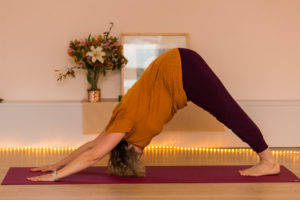 A lot of sport and fitness emphasises the development of short, powerful muscles. This means tighter hamstrings, tighter hips and a less flexible back. Yoga lengthens and strengthens skeletal muscle. With freer hips and legs the back can move more easily. A spine that can move more easily promotes freedom in the posture that allows organs, nerves, ligaments and tendons to sit and move with ease. This points to the subtle benefit of yoga which is an unblocking of energy and so flow between the body systems.
A lot of sport and fitness emphasises the development of short, powerful muscles. This means tighter hamstrings, tighter hips and a less flexible back. Yoga lengthens and strengthens skeletal muscle. With freer hips and legs the back can move more easily. A spine that can move more easily promotes freedom in the posture that allows organs, nerves, ligaments and tendons to sit and move with ease. This points to the subtle benefit of yoga which is an unblocking of energy and so flow between the body systems.
Adrenaline is a big factor in team sports, running and most forms of physical culture. Adrenaline stimulates the mind. Yoga exercise is designed to develop concentration and mental faculties, producing calm. Runners tell me that, once fluent and fit in running, a trance state is induced. However, a lot of physical culture is done to stimulating music or images. 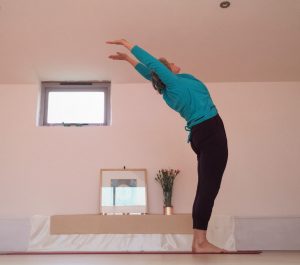 The feel-good factor after a demanding work out can be due to an endorphin high, evolution’s way of giving us stamina in extreme circumstances, not necessarily a mechanism to be exploited daily. The post-yoga glow is due to deep relaxation facilitating a connection to the self and perhaps something great than the self. If you’ve done a yoga class, you’ll know what I mean.
The feel-good factor after a demanding work out can be due to an endorphin high, evolution’s way of giving us stamina in extreme circumstances, not necessarily a mechanism to be exploited daily. The post-yoga glow is due to deep relaxation facilitating a connection to the self and perhaps something great than the self. If you’ve done a yoga class, you’ll know what I mean.
Many times, physical culture is about developing a slim, toned or muscular body that looks good to others and is fashionable; the aim of yoga is to go beyond body and mind. In Yoga, the body is regarded as an instrument for the journey to perfection. A body that is unwell or in pain does not allow the mind to meditate. The cultural poses are partly a training of the nervous system so that it is indeed possible to sit still for half an hour to meditate.
Also, yoga slows the metabolism which is great for lowering blood pressure but it won’t help with fat-burning! However, over time yoga exercise combined with other yoga practices and study, will give more insight and awareness of the mind and stop the hand reaching for another piece of cake. Yoga can give mental power as well as physical strength. Muscular development does not necessarily mean a healthy body. Health is the state of body when all organs function perfectly under the intelligent control of the mind.
Often people come to yoga as other forms of exercise have taken a toll on their body – the high impact of running, rowing, professional dancing, martial arts, cycling and contact sports were ones I often saw when teaching in London. Over-doing it meant they could no longer do those forms of exercise and were looking for something more gentle. Some even looked to restore damaged knees, for instance. 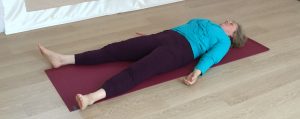 While yoga of itself can’t necessarily repair a cruciate ligament, yoga allows the body to heal itself in savasana and final relaxation.
While yoga of itself can’t necessarily repair a cruciate ligament, yoga allows the body to heal itself in savasana and final relaxation.
In savasana the mind is calmed to theta and delta states, the same as rapid eye movement (REM) and deep sleep states, which at night in sleep are necessary for rest and repair. If you do a full yoga session at least twice a day, as on retreat, for instance, you will quickly notice how fast your nails and hair grow and an improvement in your skin. Rest and repair will be deep in the tissues too. Often people take up running or gym, inspired to be healthy but more deeply also out of fear of getting old. Yoga keeps you young in a holistic way.
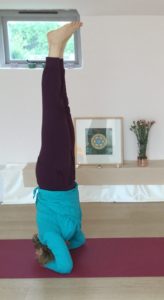 Another chief difference is that fitness training relies pretty much on aerobic exercise to increase heart pumping and thereby circulation. This puts strain on the heart, sometimes a really testing amount of strain when people train unwisely. In yoga the stretching of muscle forces blood through the valves of the veins. Inverted postures such as the headstand and shoulder stand use gravity to bring blood back to the heart. These two factors firstly increase blood circulation AND strengthen and stretch the heart muscle. The Sun Salutation warm up to yoga postures is aerobic too and is combined with a conscious breath to keep it even and avoid forcing. But even gentle yoga moves benefit the circulatory system.
Another chief difference is that fitness training relies pretty much on aerobic exercise to increase heart pumping and thereby circulation. This puts strain on the heart, sometimes a really testing amount of strain when people train unwisely. In yoga the stretching of muscle forces blood through the valves of the veins. Inverted postures such as the headstand and shoulder stand use gravity to bring blood back to the heart. These two factors firstly increase blood circulation AND strengthen and stretch the heart muscle. The Sun Salutation warm up to yoga postures is aerobic too and is combined with a conscious breath to keep it even and avoid forcing. But even gentle yoga moves benefit the circulatory system.
Yoga really encourages you to listen to the body so you do not overdo it, or, if you decide to push it, once experienced, you use your breath to strengthen and sweeten the pose. The exhale allows you to extend the stretch, the inhale brings resources. Yoga is practised in a mindful way, making observations and experimenting. This develops the faculty to observe the mind and become a more aware person. Physical exercise is done with the eyes open – some yoga classes too – and students continuously watch the teacher. The eyes draw the mind’s energy out. Yoga can be done a whole session with the eyes closed, promoting an inward focus and what is called pratyahara or withdrawal of the senses, a relaxation for the nervous system.
Lastly, two more physical benefits. In a session the body is folded and stretched in all directions: forwards, backwards, twisting and sideways. In this way the internal organs receive a full massage leading to improved digestion and general flow of blood to tissue. Glands (eg adrenal) and ductless tissues (eg the cells that produce glycogen and insulin deep in the liver) receive a massage, bringing fresh blood and taking away toxins and to promote more optimal function. Yoga really reaches the parts other exercise cannot reach! Yoga offers weight-bearing exercise, using one’s own weight and not having to rely on equipment. This is excellent to develop stronger bones and resilience to osteoporosis. In fact a major benefit of yoga is that it requires no equipment. A sticky mat is helpful and these are available inexpensively, but there is no need to spend money on special shoes, expensive equipment or drive anywhere. In addition, you can do it simply, on your own or in a group.
And very lastly, there is a thing called yoga hair – it always looks good after you’ve been practising as prana, the vital force, goes to the tips of the hair too. And no need to shower – just rub in any sweat as it too is full of prana.
I hope this inspires you to add yoga to your other exercise and, if already practising, to practise more.
Now read about the benefits of pranayama, the other activity in the class
Zumba with Sophie at North Tawton Rugby Club on Monday evenings and Tuesday mornings North Tawton Zumba